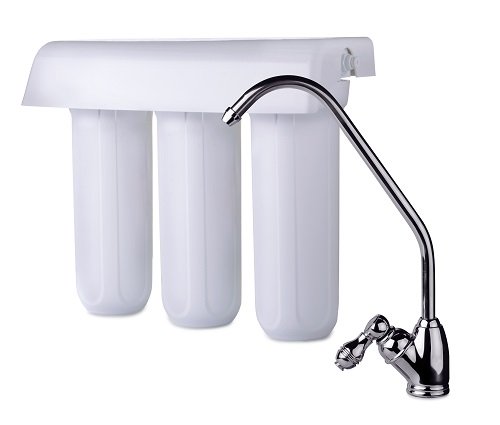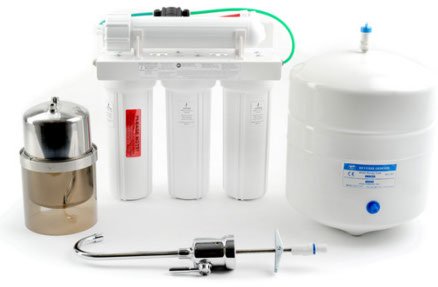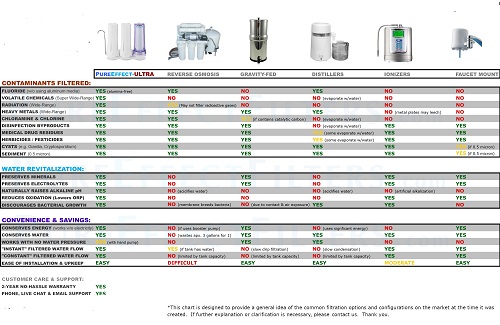The best water filter options in Palma de Mallorca & the Mediterranean
Water Filter Options
What's YOUR Best Water Filter Option?
Your options basically come down to just a few categories:
Carafe or Pitcher Style Filter
The pour-through pitcher style filter is generally the least effective filter when it comes to removing harmful contaminants.
Certified to remove only five substances, a pitcher-style filter is designed primarily for taste and odor. Most importantly, these typically do NOT remove dangerous THMs, VOCs, and cysts.
Although their initial cost may be only about 25.00 EUR, you'll need to replace cartridges every 90 liters. All figured, at a whopping cost of 10 cents per liter, these filters are the most costly on an on-going basis.
Plus if you forget to refill the small reservoir after use, you're out of water!
Granular Carbon and Carbon Block Filters
These are the most common types of counter top and under counter water filters.I think this is the best long-term solution for in-home water filtration. Typically the most robust and effective filtration technology. It reduces about 10x more contaminants than the leading pitcher filter. These are typically the longest lasting filters compared to countertop or pitcher options
Granular carbon filters and carbon block systems perform the same process of contaminant removal, adsorption, which is the chemical or physical bond of a contaminant to the surface of the filter media.
Granular activated carbon is recognized by the EPA as the best available technology for the removal of organic chemicals like herbicides, pesticides, and industrial chemicals.
Carbon block filters offer the same superior filtering ability but are compressed with the carbon medium in a solid form. This eliminates channeling and gives the ability to precisely combine multiple media in a sub-micron filter cartridge. By combining different media, the ability to selectively remove a wide range of contaminants can be achieved.
A sub-micron pore structure gives the added benefit of cyst reduction. By creating a sub-micron physical barrier, the filter can eliminate dangerous organisms like Cryptosporidium and Giardia.
Ideally, you want a filtration system that offers a variety of methods to remove different contaminants. Most systems do not address a combination of organic, inorganic, cyst, sediment and metals.
Reverse Osmosis Filter
RO systems can remove over 70 contaminants, more than any other single water filtration system. Reverse osmosis (RO) filters generally remove more impurities, including hard-to-remove fluoride. However, they also remove natural minerals in the water.
The Multipure AquaRO reduces the largest number of contaminants of any water filtration system reviewed. This system can reduce up to 82 contaminants from your drinking water. It uses a five-stage process to filter your water, and the filters have a lifespan of approximately six months. This drinking water filter system will fit nicely underneath your kitchen sink and comes with an included faucet. However, it does have several drawbacks, including
This water filter system can reduce up to 82 contaminants from your drinking water. These contaminants include cysts, chlorine, lead and asbestos. However, the system cannot reduce various bacteria from your drinking water, while many the best water filtration systems do offer that capability. Below is an approximate number of contaminants the system will reduce in your water.
- 6 MULTIPURE AQUARO 82 Contaminants
- 1 AQUASANA 3-STAGE UNDER COUNTER 66 Contaminants
- 2 WATERCHEF U9000 50 Contaminants
- 3 APEC WATER ROES 5040 Contaminants
- CATEGORY AVERAGE 38.00 Contaminants
This system uses five stages to filter your water. It includes three pre-filters, an RO membrane and a post filter. Each stage of the water filtering process will remove different contaminants from your water, including heavy metals and chemicals. The three pre-filters on this product have a lifespan of approximately six months, while the RO membrane can last two to three years.
There is a standard faucet included with this system, but there are no faucet options. ear warranty, which is the average warranty you will find on this type of product.
You must add the essential minerals back into my water, but it's an extra step you must remember to do for naturally healthy water. RO filters also tend to be more expensive, but worth it and essential in some places, like Palma.
Ion Exchange Filter
Ion exchange is designed to remove dissolved salts in the water, such as calcium. This system actually softens the water or exchanges natural-forming mineral ions in the water with its own ions, thereby neutralizing their harmful effect of creating scale build-up.
The ion exchange system was originally used in boilers and other industrial situations before becoming popular in home purifying units, which usually combine the system with carbon for greater effectiveness.
Distillation Filter
Distillation is the simple process of boiling water to create steam. The steam cools and condenses to form mineral-free water droplets, which are deposited in a container. When combined with carbon, the result is typically 99.9% contaminate-free water.
Like a reverse osmosis filter, all healthy minerals are removed.

or

Selecting Water Treatments
|
|
|
|
|
|
|
|
|
|
|
|
|
|
|
|
|
|
|
|
|
|
|
|
|
|
|
|
|
|
|
|
Selecting water treatments specially for rural water supplies is challenging because there is rarely a single solution. Many people make the mistake of adopting one technology and assuming it will do the whole job. This is rarely the case because water varies so much in its characteristics and no two situations are the same. It is sometimes useful to think in terms of progressive barriers. This means slowly treating water by removing contaminants in a sequence of steps.
Sometimes the first step is to change the pH or oxygenation level. Many water treatments include a filtration step using a mechanical filter like a fast sand filter, a large cartridge filter or a DE filter because most filter setups do require some type of sediment filter.
For a domestic supply some treatments are best before the water enters the house. You will probably want to disinfect your drinking water. Do this with a UV steriliser or a Reverse Osmosis system at the point of use or perhaps earlier using chlorination.
You really need to pay attention to where you collect or store your water this may be a good place for some aeration and perhaps use of a flocculant followed by time to settle.
Somewhere in between you will want to treat some specific problems - if you've got them, like too much Manganese, or organic chemicals that might possibly be in your water.
It's a good idea to get a water test before you choose a filter because there are many subtleties you need to know about so your filters will actually work after you pay out your money.
1. Chlorination
Chlorination is mainly used as a control for microorganisms. It also breaks down organic matter in water and removes some metals by making them less soluble.
Chlorination is carried out by adding chlorine gas or sodium hypochlorite to water (use pool chlorine not the bleach that contains sodium hydroxide). The levels have to be monitored to ensure adequate exposure time as well as safe drinking levels. It is mainly used for large scale disinfecting so don't try this at home folks! Well actually you can do this at home. The Victorian Govt Department of Human Services says you can use chlorine to disinfect tanks so that's good enough for me. Your local Labs will help you figure out how much Chlorine to use, whether your pH is right for disinfection and how to know when you can resume drinking your water. Nowdays people are getting alarmed because chlorination actually produces some water nasties - so always use a carbon filter if your water has been chlorinated.
2. Filtration
2a. Sediment filtration Water can contain all sorts of sediment from rust to insects, dirt, algae and bits of washed in plant matter. Particle filters come in various grades - mesh or pore sizes. If water is very contaminated start with a coarse filter then add a finer filter. Use a sediment filter first before passing water through either a carbon filter or a reverse osmosis process. A standard for household supplies is the 1 micron pore size filter cartridge. These are cheap and effective. Some coarser filters are washable for example pleated sediment cartridges. Try a 0.5 micron filter if you are concerned about disease microorganisms. Some carbon cartridges can filter microorganisms. Ceramic cartridges can filter out approximately 99.99% of bacteria.
2b. Activated carbon filtration Activated carbon filters are good for removing the chemicals which cause tastes and odours. They can remove a very wide range of organic compounds which makes them almost essential for treating drinking water. Luckily convenient filters which use activated carbon are readily available for household use and are relatively cheap. Here is a summary of the types of chemicals they can reduce: toxic by products of chlorination (trihalomethanes), Polynuclear Aromatic Hydrocarbons (some carcinogenic compounds), most of the Phase I and Phase II organics regulated under the US Safe Drinking Water Act.
2c. Slow Sand filtration
Sand filters have been used for a long time for treating drinking water. Their great advantage is that they are cheap, low tech and effective. Water is passed slowly downward through a container of sand which is organised from large to small particle sizes (upwards). The water moves slowly by gravity only. They are specially good for removing organic matter, fungi, bad bacteria and even some viruses. Sand filters can also be used to treat recycled water. The media can also be lightweigh material like rockwool.
2d. Fast Sand filtration.
This is a commonly used method. The water is passed upwards through fine sand. This is done under pressure so the filter is sealed. Most filters can be set to automatically perform a backwash to clean themselves. It's possible to put different types of media or combinations of media in these filters for example sand and anthracite.
2e. Settling.
Just let the water stand if you have suspended particles which will settle by themselves. Use a clear container to test a small sample. Some of the particles from natural surface waters for example may take a little while to settle.
2f. DE fitration.
DE stands for diatomaceous earth. Its a powder which is just about inert and packs down to trap right down to very small dirt and algae. The best setup for a DE filter is to use it to continuously or frequently cycle water from a tank, through the filter and back into the tank. This way the filter works to keep the water clean. Use a small electric pump to push water through the filter. Inside the filter there are a lot of porous plates. The idea is that you mix up a DE slurry and poor it into the filter chamber. Just let the water cycle through the filter for a while so that the DE coats the porous plates. Now it will do it's work until the little guage on top says the filter is getting clogged up. Just turn a tap to change direction of the flow and you'll flush out all the old DE. DE filters can trap Giardia and Cryptosporidium spores so for this reason alone they are worth looking at for rural water supplies. And what's really good is that they are one of the best ways to trap that nuisance algae so common in farm water supplies.
These single celled algae are about 4 microns x 7 microns. They are difficult to remove from water specially if there are a lot of them because they may quickly clog a filter. Try a DE filter. This can be backwashed and replenished when it reaches it's capacity.
2g. Microfiltration, ultrafiltration and nanofiltration.
These are newer technologies that show improved possibilities for removing particles between 1/2 micron and the ions that are removed by reverse osmosis. Ultrfiltration can remove viruses and colloids and nanofiltration can remove the larger ions that cause water hardness.
3. Distillation
Distillation means boiling water and collecting and condensing the steam. This is really good for removing metals and salts. Use distillation with care if the water contains more than a little organic matter or organic compounds as these may find their way back into the condensed water.
4. Reverse osmosis
Reverse osmosis uses water pressure to push the water through a very fine membrane. This membrane stops nearly everything except very small molecules. A good household system has a sediment pre filter, a reverse osmosis membrane and then a final activated carbon filter to clean up small organic molecules. Apart from removing most bacteria and viruses, reverse osmosis will remove typically up to 95 - 99% of salts and metal ions. It's probably one of the best ways to remove salts and pathogens but your water has to be reasonably clean beofre going through the RO unit otherwise it will clog up too quickly.
5. Ultraviolet irradiation
With this method you'll need to buy an ultraviolet steriliser. Water is passed in clear tubes between ultraviolet lights. Ultraviolet light is effective against bacteria, fungi and protozoan cysts incl Giardia and Cryptosporidium. Some units are quite neat and will give you more confidence about your water quality. The water needs to be very clear so the UV can be effective. A UV sterilizer is usually the final step in treating drinking water.
6. Ion exchange resins
A large number of different ion exchange resins are available to reduce particular contaminants. They are usually recommended for specific problems. They have been used to reduce hardness, iron, manganese and many other ions in water. Ion exchange cartridges are available for household use and some are even combined into a single cartridge with activated carbon.
7. Acid neutralisation Various chemicals are added to water to reduce the acidity and the tendency for corrosion of metal particularly in pipes. These include sodium bicarbonate. The choice depends largely on the existing hardness and alkalinity of the water. For home use its better to install a calcite cartridge filter. The calcite slowly dissolves as you use the water, but it is better before the water comes into contact with any Copper pipes.
8. Water softening Lime Calcium hydroxide and soda ash (Sodium carbonate) are often used to remove hardness and scale forming compounds in water. Calcium and Magnesium can also be removed by ion exchange.
9. Aeration Aeration is basically speeding up the rate of air mixing with water. Oxygen breaks down organic compounds converting them to less harmful forms compared to what happens if there is low oxygen. Aeration works for iron because the iron which is usually dissolved in water reacts with the oxygen to form less soluble compounds. These settle if the water is left to stand or they can be filtered. The simplest way to aerate water is to pump it through a venturi aerator which forces air bubbles into the water stream. There are a number of other technologies designed to increase the efficiency of aeration like diffusers, spraying, bubblers, towers, and surface agitators.
10. Boiling Boiling reduces pathogens like bacteria and some microorganisms.
11. Ozonization
Ozone is like oxygen but more effective. It works by efficiently oxidizing organic matter or metals or killing many microorganisms. It needs a special ozone generator and a diffuser to go in the water. It may under certain conditions be a good alternative to chlorine. Here are some of the things it reduces: kills bacteria and viruses, kills algal and fungal spores, precipitates heavy metals, removes excess iron, manganese and sulphur, removes colour and odour, reduces scale build up.
12. Flocculation.
This method is good for water which is discoloured by colloids. These are very small particles that don't settle and can't be filtered. Usually a flocculant chemical such as aluminium sulphate is added by a dosing pump which adds a small amount of flocculant to the water as it is being mixed or circulated in a tank. The aluminium part makes the colloids clump together so they settle. This may take a while so you will need a good sized tank. Afterwards run the water through a fast sand filter or a large cartridge filter. If you get a test done on your water by a good lab How to get a water test you can find out how much flocculant to use. That way all the aluminium will be used up in settling out the colloids and very little will end up in your finished water, apparently.
13. Constructed wetlands. As strange as it may seem, wetlands can improve water quality specially by removing nutrients like nitrates and phosphates. And this is achieved through natural processes. So constructing an artificial wetland makes sense both for improving the quality of a water supply, for treating waste water before discharge or even in recycling. Phosphates are usually removed through binding to sediments whereas nitrates are removed by conversion to harmless nitrogen gas through a process called denitrification. Wetlands can also reduce the organic loading in water by allowing bacteria to consume organic matter in the water.
Treatment options: This list may not include all possible contaminants, problems or treatments and doesn't mean that a given treatment will completely solve a particular problem. Remember there are no right and wrong ways to treat water only guidelines, good data and common sense.
